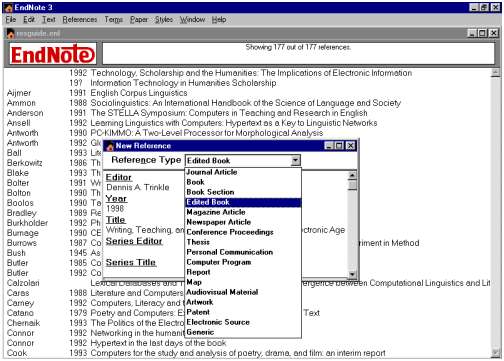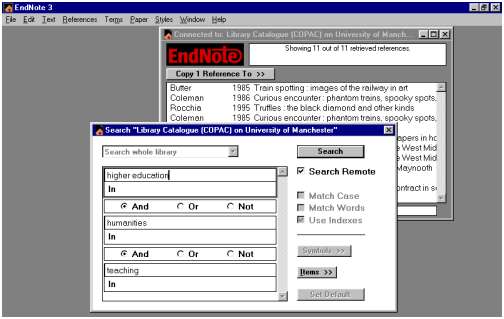
Fig. 1. Adding a new reference in EndNote 3.0
| Computers & Texts No.
16/17 |
Table
of Contents |
Winter 1998 |
Christopher Stephens
Humanities Computing
Unit
University of Oxford
christopher.stephens@oucs.ox.ac.uk
In preparation for writing a full, comparative review for Computers & Texts 18 of the various software packages available for managing bibliographic references, I have been looking at the new version of EndNote by Niles Software (version 3.0.1) available for both Mac and PC. This version includes some significant developments and it seemed useful to include a short overview here before a more extensive evaluation appears in the next issue.
The interface is much the same as for earlier versions of EndNote. This is a Windows95 program and includes the standard windows menus for file management, edit, help and so on, as well as EndNote specific menus, such as the references menu for functions like adding new references, sorting, and searching.
New references are added by choosing the reference type from a drop down list and filling in the details in the appropriate fields. Reference types range from journal article, book, or book chapter to thesis, report or patent. Significantly, there are also reference types for electronic source, computer program, and audio-visual material. Most of the reference types also include a URL field to reference online material. Up to four fields can be customised by the user.
 |
|
Fig. 1. Adding a new reference in EndNote 3.0 |
As you would expect the new version allows you to store your references in a neutral format and then output your bibliography in any of a number of styles, including MLA, Chicago, and a host of scientific journal styles. Fortunately, it is also possible to define your own styles and additional styles are made available on the the publisher's Web site.
A strength of EndNote is the possibilities offered through integration with popular word processors and this continues to apply in this version. The installation adds EndNote commands to Word 97, Word 6.0, and WordPerfect. Amongst other things these tools allow one to insert a place-holder for EndNote references which can later be scanned by the program and converted to the in-text citation and bibliographic style of your choosing.
These features are all, more or less, present in the earlier versions of
EndNote. What makes this version stand out, however, is the new 'connect'
feature. It is now possible to search remote library databases from within
EndNote running on a machine connected to the Internet. Once connected you
can search the catalogue, mark files of interest, and download the full
references directly into EndNote. The connect feature relies on the
library catalogue being compliant with the Z39.50 protocol. This includes
most of the big research libraries as well as COPAC and RLG. EndNote uses
its own special connect files to access these databases and, again, the
package comes complete with connect files for many different libraries and
collections. It is also possible to create your own connect file for any
Z39.50 server. We have acquired locally produced connect files for COPAC
and OLIS (the Oxford union of library catalogues). The production of these
files requires fairly basic knowledge of the library server's
configuration. A list of Z39.50 targets in the UK is maintained by UKOLN
at http://www.ukoln.ac.uk/dlis/zdir/.
Further information about EndNote's Z39.50 capabilities as well as a
growing number of EndNote connection files is available through the Niles
Software Web page at http://www.niles.com/home/z3950.htm.
 |
|
Searching the COPAC database with EndNote 3.0 |
[Table of Contents] [Letter to the Editor]
Computers & Texts 16/17 (1998). Not to be republished in any
form without the author's permission.
HTML Author:
Michael Fraser
Document Created: 22 December 1998
Document
Modified: 6 April 1999
The URL of this document is
http://info.ox.ac.uk/ctitext/publish/comtxt/ct16-17/stephens.html